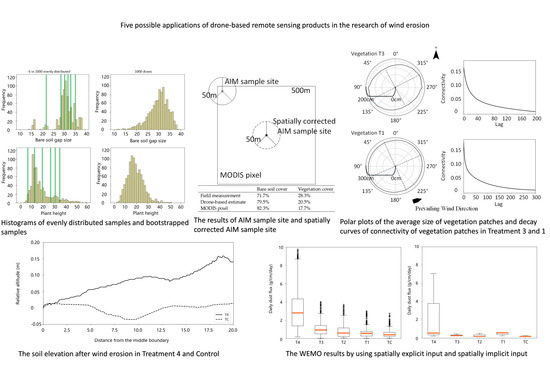Drone-Based Remote Sensing for Research on Wind Erosion in Drylands: Possible Applications
Abstract
1. Introduction
2. Difficulties with Field Observation
2.1. Insufficient Samples
2.2. Spatial Displacement with Auxiliary Datasets
2.3. Missing Volumetric Information
2.4. Unidirectional View
2.5. Spatially Inexplicit Input
3. Data and Possible Applications
3.1. Study Area
3.2. Data Preparation
3.3. Possible Applications
3.3.1. Provide a Reliable and Valid Sample Set
3.3.2. Mitigating the Spatial Offset
3.3.3. Soil Elevation
3.3.4. Directional Property of Landscape
3.3.5. Spatially Explicit Input
4. Results and Discussion
4.1. Provide a Reliable and Valid Sample Set
4.2. Mitigating the Spatial Offset
4.3. Soil Elevation
4.4. Directional Property of Landscape
4.5. Spatially Explicit Input
5. Conclusions
Author Contributions
Funding
Institutional Review Board Statement
Informed Consent Statement
Data Availability Statement
Conflicts of Interest
References
- Webb, N.P.; Okin, G.S.; Brown, S. The effect of roughness elements on wind erosion: The importance of surface shear stress distribution. J. Geophys. Res. Atmos. 2014, 119, 6066–6084. [Google Scholar] [CrossRef]
- Shao, Y. Physics and Modelling of Wind Erosion; Springer: Amsterdam, The Netherlands, 2000. [Google Scholar]
- Belnap, J.; Gillette, D.A. Vulnerability of desert biological soil crusts to wind erosion: The influences of crust development, soil texture, and disturbance. J. Arid Environ. 1998, 39, 133–142. [Google Scholar] [CrossRef]
- Bhattachan, A.; Okin, G.S.; Zhang, J.; Vimal, S.; Lettenmaier, D.P. Characterizing the role of wind and dust in traffic accidents in California. GeoHealth 2019, 3, 328–336. [Google Scholar] [CrossRef] [PubMed]
- Okin, G.S.; Sala, O.E.; Vivoni, E.R.; Zhang, J.; Bhattachan, A. The interactive role of wind and water in functioning of drylands: What does the future hold? Bioscience 2018, 68, 670–677. [Google Scholar] [CrossRef]
- Zhang, J. Multi-Scale Vegetation-Aeolian Transport Interaction in Drylands: Remote Sensing and Modeling; UCLA: Los Angeles, CA, USA, 2019. [Google Scholar]
- Hogland, J.; Affleck, D.L. Mitigating the impact of field and image registration errors through spatial aggregation. Remote Sens. 2019, 11, 222. [Google Scholar] [CrossRef]
- Cunliffe, A.M.; Brazier, R.E.; Anderson, K. Ultra-fine grain landscape-scale quantification of dryland vegetation structure with drone-acquired structure-from-motion photogrammetry. Remote Sens. Environ. 2016, 183, 129–143. [Google Scholar] [CrossRef]
- McGlynn, I.O.; Okin, G.S. Characterization of shrub distribution using high spatial resolution remote sensing: Ecosystem implications for a former Chihuahuan Desert grassland. Remote Sens. Environ. 2006, 101, 554–566. [Google Scholar] [CrossRef]
- DeAngelis, D.L.; Yurek, S. Spatially explicit modeling in ecology: A review. Ecosystems 2017, 20, 284–300. [Google Scholar] [CrossRef]
- Daftry, S.; Hoppe, C.; Bischof, H. Building with drones: Accurate 3d facade reconstruction using mavs. In Proceedings of the 2015 IEEE International Conference on Robotics and Automation (ICRA), Seattle, DC, USA, 26–30 May 2015; pp. 3487–3494. [Google Scholar]
- Gillan, J.K.; Karl, J.W.; Elaksher, A.; Duniway, M.C. Fine-Resolution Repeat Topographic Surveying of Dryland Landscapes Using UAS-Based Structure-from-Motion Photogrammetry: Assessing Accuracy and Precision against Traditional Ground-Based Erosion Measurements. Remote Sens. 2017, 9, 437. [Google Scholar] [CrossRef]
- Herrick, J.E.; Van Zee, J.W.; Havstad, K.M.; Burkett, L.M.; Whitford, W.G.; Bestelmeyer, B.T.; Melgoza, A.; Pellant, M.; Pyke, D.A.; Remmenga, M.D. Monitoring manual for grassland, shrubland and savanna ecosystems. In Volume I: Core Methods; USDA-ARS Jornada Experimental Range: Las Cruces, NM, USA, 2005. [Google Scholar]
- Webb, N.P.; Chappell, A.; Edwards, B.L.; McCord, S.E.; Van Zee, J.W.; Cooper, B.F.; Courtright, E.M.; Duniway, M.C.; Sharratt, B.; Tedela, N. Reducing sampling uncertainty in aeolian research to improve change detection. J. Geophys. Res. Earth Surf. 2019, 124, 1366–1377. [Google Scholar] [CrossRef]
- Karl, J.W.; McCord, S.E.; Hadley, B.C. A comparison of cover calculation techniques for relating point-intercept vegetation sampling to remote sensing imagery. Ecol. Indic. 2017, 73, 156–165. [Google Scholar] [CrossRef]
- Duniway, M.C.; Karl, J.W.; Schrader, S.; Baquera, N.; Herrick, J.E. Rangeland and pasture monitoring: An approach to interpretation of high-resolution imagery focused on observer calibration for repeatability. Environ. Monit. Assess. 2012, 184, 3789–3804. [Google Scholar] [CrossRef] [PubMed]
- Zhang, J.; Okin, G.S.; Zhou, B.; Karl, J.W. Quantifying rangeland indicators from drone-based remote sensing images: Experiments and applications. Ecosphere 2021, in press. [Google Scholar]
- Webb, N.P.; Van Zee, J.W.; Karl, J.W.; Herrick, J.E.; Courtright, E.M.; Billings, B.J.; Boyd, R.; Chappell, A.; Duniway, M.C.; Derner, J.D. Enhancing wind erosion monitoring and assessment for US rangelands. Rangelands 2017, 39, 85–96. [Google Scholar] [CrossRef]
- McCord, S.E.; Buenemann, M.; Karl, J.W.; Browning, D.M.; Hadley, B.C. Integrating Remotely Sensed Imagery and Existing Multiscale Field Data to Derive Rangeland Indicators: Application of Bayesian Additive Regression Trees. Rangel. Ecol. Manag. 2017, 70, 644–655. [Google Scholar] [CrossRef]
- Zhou, B.; Okin, G.S.; Zhang, J. Leveraging Google Earth Engine (GEE) and machine learning algorithms to incorporate in situ measurement from different times for rangelands monitoring. Remote Sens. Environ. 2020, 236, 111521. [Google Scholar] [CrossRef]
- Zhang, J.; Okin, G.S.; Zhou, B. Assimilating optical satellite remote sensing images and field data to predict surface indicators in the Western US: Assessing error in satellite predictions based on large geographical datasets with the use of machine learning. Remote Sens. Environ. 2019, 233, 111382. [Google Scholar] [CrossRef]
- Hogland, J.; Anderson, N. Function modeling improves the efficiency of spatial modeling using big data from remote sensing. Big Data Cogn. Comput. 2017, 1, 3. [Google Scholar] [CrossRef]
- Schmid, J.N. Using Google Earth Engine for Landsat NDVI Time Series Analysis to Indicate the Present Status of Forest Stands. Bachelor’s Thesis, Georg-August-University, Göttingen, Germany, October 2017. [Google Scholar]
- Masinde, C.; Rono, D.; Hahn, M. Estimation of the degree of surface sealing with Sentinel 2 data using building indices. Earth Obs. Geomat. Eng. 2019, 3, 112–119. [Google Scholar]
- Herrick, J.E.; Lessard, V.C.; Spaeth, K.E.; Shaver, P.L.; Dayton, R.S.; Pyke, D.A.; Jolley, L.; Goebel, J.J. National ecosystem assessments supported by scientific and local knowledge. Front. Ecol. Environ. 2010, 8, 403–408. [Google Scholar] [CrossRef]
- Gillan, J.K.; Karl, J.W.; Barger, N.N.; Elaksher, A.; Duniway, M.C. Spatially explicit rangeland erosion monitoring using high-resolution digital aerial imagery. Rangel. Ecol. Manag. 2016, 69, 95–107. [Google Scholar] [CrossRef]
- Nichols, M. Measured sediment yield rates from semiarid rangeland watersheds. Rangel. Ecol. Manag. 2006, 59, 55–62. [Google Scholar] [CrossRef]
- Sirvent, J.; Desir, G.; Gutierrez, M.; Sancho, C.; Benito, G. Erosion rates in badland areas recorded by collectors, erosion pins and profilometer techniques (Ebro Basin, NE-Spain). Geomorphology 1997, 18, 61–75. [Google Scholar] [CrossRef]
- Wilcox, B.; Davenport, D.; Pitlick, J.; Allen, C. Runoff and Erosion from a Rapidly Eroding Pinyon-Juniper Hillslope; Los Alamos National Lab.: Los Alamos, NM, USA, 1996.
- Lucieer, A.; Jong, S.M.d.; Turner, D. Mapping landslide displacements using Structure from Motion (SfM) and image correlation of multi-temporal UAV photography. Prog. Phys. Geogr. 2014, 38, 97–116. [Google Scholar] [CrossRef]
- Estrany, J.; Ruiz, M.; Calsamiglia, A.; Carriquí, M.; García-Comendador, J.; Nadal, M.; Fortesa, J.; López-Tarazón, J.A.; Medrano, H.; Gago, J. Sediment connectivity linked to vegetation using UAVs: High-resolution imagery for ecosystem management. Sci. Total Environ. 2019, 671, 1192–1205. [Google Scholar] [CrossRef]
- Webb, N.P.; Kachergis, E.; Miller, S.W.; McCord, S.E.; Bestelmeyer, B.T.; Brown, J.R.; Chappell, A.; Edwards, B.L.; Herrick, J.E.; Karl, J.W. Indicators and benchmarks for wind erosion monitoring, assessment and management. Ecol. Indic. 2020, 110, 105881. [Google Scholar] [CrossRef]
- Peters, D.P.; Okin, G.S.; Herrick, J.E.; Savoy, H.M.; Anderson, J.P.; Scroggs, S.L.; Zhang, J. Modifying connectivity to promote state change reversal: The importance of geomorphic context and plant–soil feedbacks. Ecology 2020, e03069. [Google Scholar] [CrossRef]
- Okin, G.S.; Moreno-de las Heras, M.; Saco, P.M.; Throop, H.L.; Vivoni, E.R.; Parsons, A.J.; Wainwright, J.; Peters, D.P.C. Connectivity in dryland landscapes: Shifting concepts of spatial interactions. Front. Ecol. Environ. 2015, 13, 20–27. [Google Scholar] [CrossRef]
- Turner, M.G.; Arthaud, G.J.; Engstrom, R.T.; Hejl, S.J.; Liu, J.; Loeb, S.; McKelvey, K. Usefulness of spatially explicit population models in land management. Ecol. Appl. 1995, 5, 12–16. [Google Scholar] [CrossRef]
- Wu, J.; David, J.L. A spatially explicit hierarchical approach to modeling complex ecological systems: Theory and applications. Ecol. Model. 2002, 153, 7–26. [Google Scholar] [CrossRef]
- Dunning, J.B., Jr.; Stewart, D.J.; Danielson, B.J.; Noon, B.R.; Root, T.L.; Lamberson, R.H.; Stevens, E.E. Spatially explicit population models: Current forms and future uses. Ecol. Appl. 1995, 5, 3–11. [Google Scholar] [CrossRef]
- Zhang, J. A new ecological-wind erosion model to simulate the impacts of aeolian transport on dryland vegetation patterns. Acta Ecol. Sin. 2020. [Google Scholar] [CrossRef]
- Okin, G.S. A new model of wind erosion in the presence of vegetation. J. Geophys. Res. Earth 2008, 113, 954. [Google Scholar] [CrossRef]
- Zhang, J.; Zhu, W.; Dong, Y.; Jiang, N.; Pan, Y. A spectral similarity measure based on Changing-Weight Combination Method. Acta Geod. Cartogr. Sin. 2013, 42, 418–424. [Google Scholar]
- Tou, J.T.; Gonzalez, R.C. Pattern Recognition Principles; Addison-Wesley Publishing Company: Boston, MA, USA, 1974. [Google Scholar]
- Gillan, J.K.; Karl, J.W.; Duniway, M.; Elaksher, A. Modeling vegetation heights from high resolution stereo aerial photography: An application for broad-scale rangeland monitoring. J. Environ. Manag. 2014, 144, 226–235. [Google Scholar] [CrossRef]
- Warmerdam, F. The geospatial data abstraction library. In Open Source Approaches in Spatial Data Handling; Springer: Berlin/Heidelberg, Germany, 2008; pp. 87–104. [Google Scholar]
- Meyer, T.; Okin, G.S. Evaluation of spectral unmixing techniques using MODIS in a structurally complex savanna environment for retrieval of green vegetation, nonphotosynthetic vegetation, and soil fractional cover. Remote Sens. Environ. 2015, 161, 122–130. [Google Scholar] [CrossRef]
- Campbell, J.B.; Wynne, R.H. Introduction to Remote Sensing; Guilford Press: New York, NY, USA, 2011. [Google Scholar]
- Jensen, J.L.; Mathews, A.J. Assessment of image-based point cloud products to generate a bare earth surface and estimate canopy heights in a woodland ecosystem. Remote Sens. 2016, 8, 50. [Google Scholar] [CrossRef]
- Dandois, J.P.; Ellis, E.C. High spatial resolution three-dimensional mapping of vegetation spectral dynamics using computer vision. Remote Sens. Environ. 2013, 136, 259–276. [Google Scholar] [CrossRef]
- Hongyue, D.; Junzhe, Z.; Huili, G. Research of DEM quality-precision analysis and system implementation. Sci. Surv. Mapp. 2009, 4, 191–194. [Google Scholar]
- Sibson, R. A brief description of natural neighbour interpolation. In Interpreting Multivariate Data; Barnett, V., Ed.; Wiley: New York, NY, USA, 1981. [Google Scholar]
- Vest, K.R.; Elmore, A.J.; Kaste, J.M.; Okin, G.S.; Li, J.R. Estimating total horizontal aeolian flux within shrub-invaded groundwater-dependent meadows using empirical and mechanistic models. J. Geophys. Res. Earth 2013, 118, 1132–1146. [Google Scholar] [CrossRef]
- Lancaster, N.; Nickling, W.G.; Gillies, J.A. Sand transport by wind on complex surfaces: Field studies in the McMurdo Dry Valleys, Antarctica. J. Geophys. Res. Earth Surf. 2010, 115, 115. [Google Scholar] [CrossRef]
- Li, J.R.; Okin, G.S.; Herrick, J.E.; Belnap, J.; Miller, M.E.; Vest, K.; Draut, A.E. Evaluation of a new model of aeolian transport in the presence of vegetation. J. Geophys. Res. Earth 2013, 118, 288–306. [Google Scholar] [CrossRef]
- Mayaud, J.R.; Bailey, R.M.; Wiggs, G.F. A coupled vegetation/sediment transport model for dryland environments. J. Geophys. Res. Earth Surf. 2017, 122, 875–900. [Google Scholar] [CrossRef]
- Gillette, D.A.; Chen, W. Particle production and aeolian transport from a “supply-limited” source area in the Chihuahuan desert, New Mexico, United States. J. Geophys. Res. Atmos. 2001, 106, 5267–5278. [Google Scholar] [CrossRef]
- Gillette, D.A.; Adams, J.; Endo, A.; Smith, D.; Kihl, R. Threshold velocities for input of soil particles into the air by desert soils. J. Geophys. Res. Ocean. 1980, 85, 5621–5630. [Google Scholar] [CrossRef]
- Alvarez, L.J.; Epstein, H.E.; Li, J.R.; Okin, G.S. Aeolian process effects on vegetation communities in an arid grassland ecosystem. Ecol. Evol. 2012, 2, 809–821. [Google Scholar] [CrossRef]
- Gillette, D.A.; Pitchford, A.M. Sand flux in the northern Chihuahuan Desert, New Mexico, USA, and the influence of mesquite-dominated landscapes. J. Geophys. Res. Earth Surf. 2004, 109. [Google Scholar] [CrossRef]
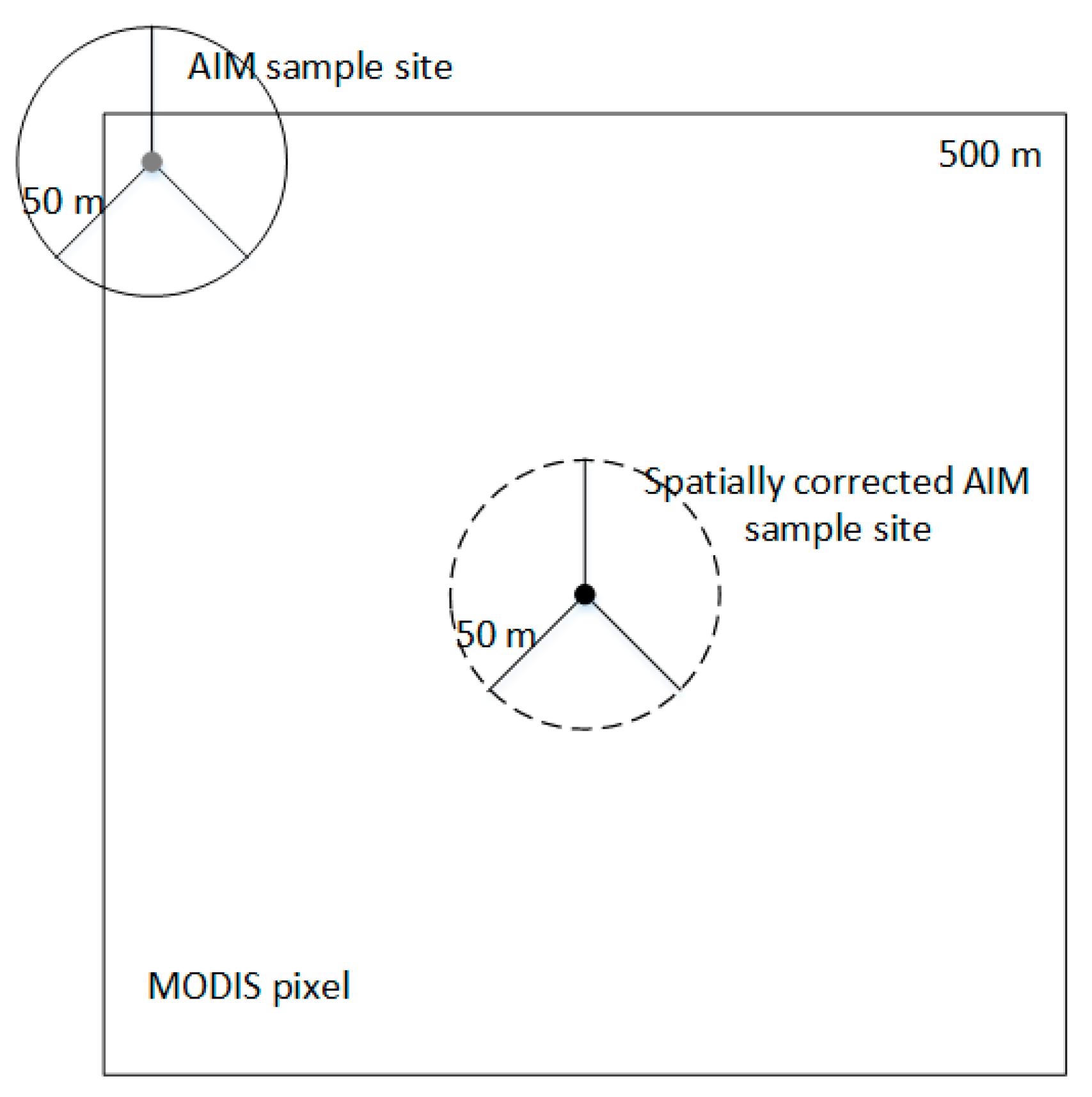

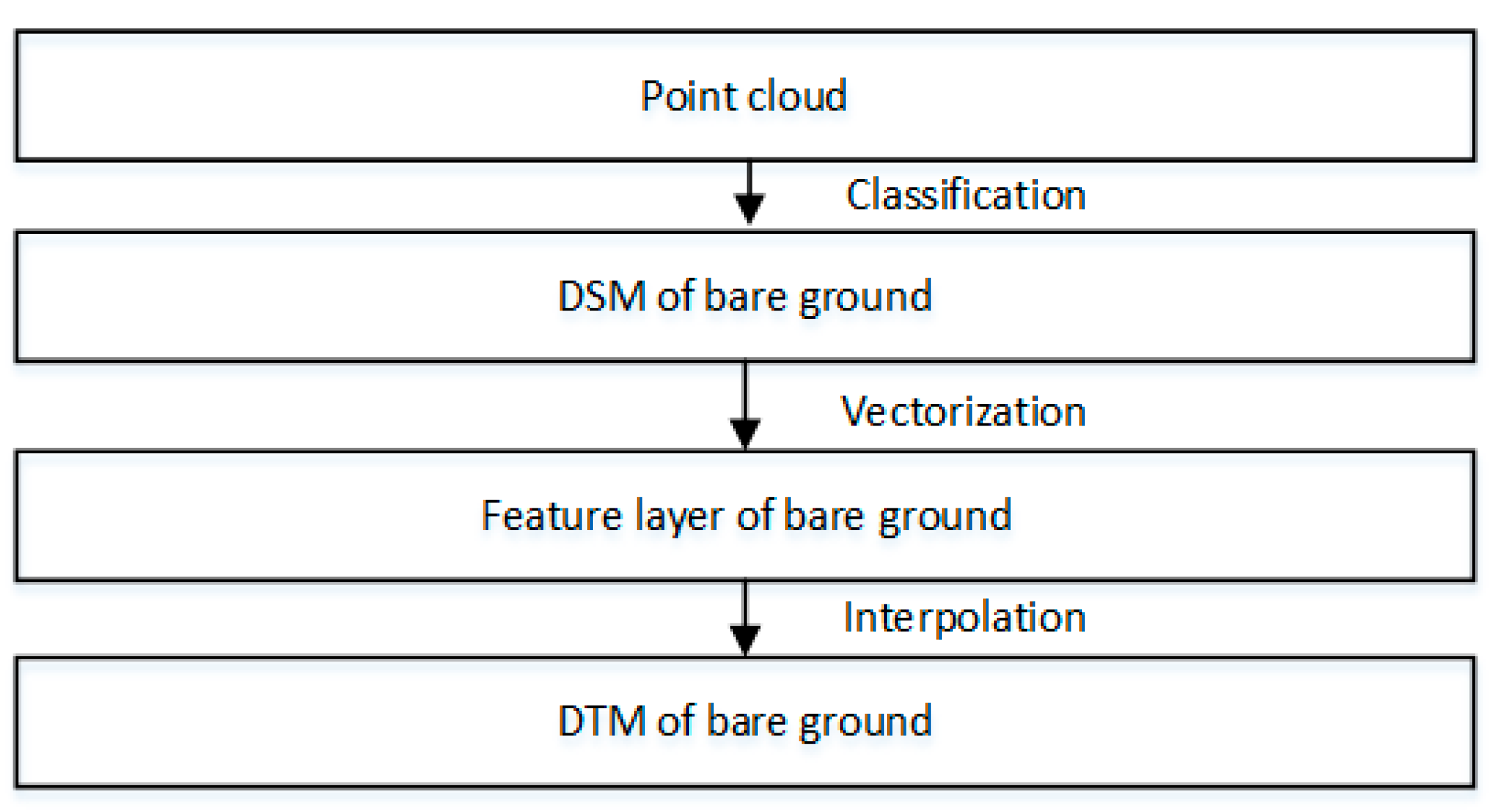
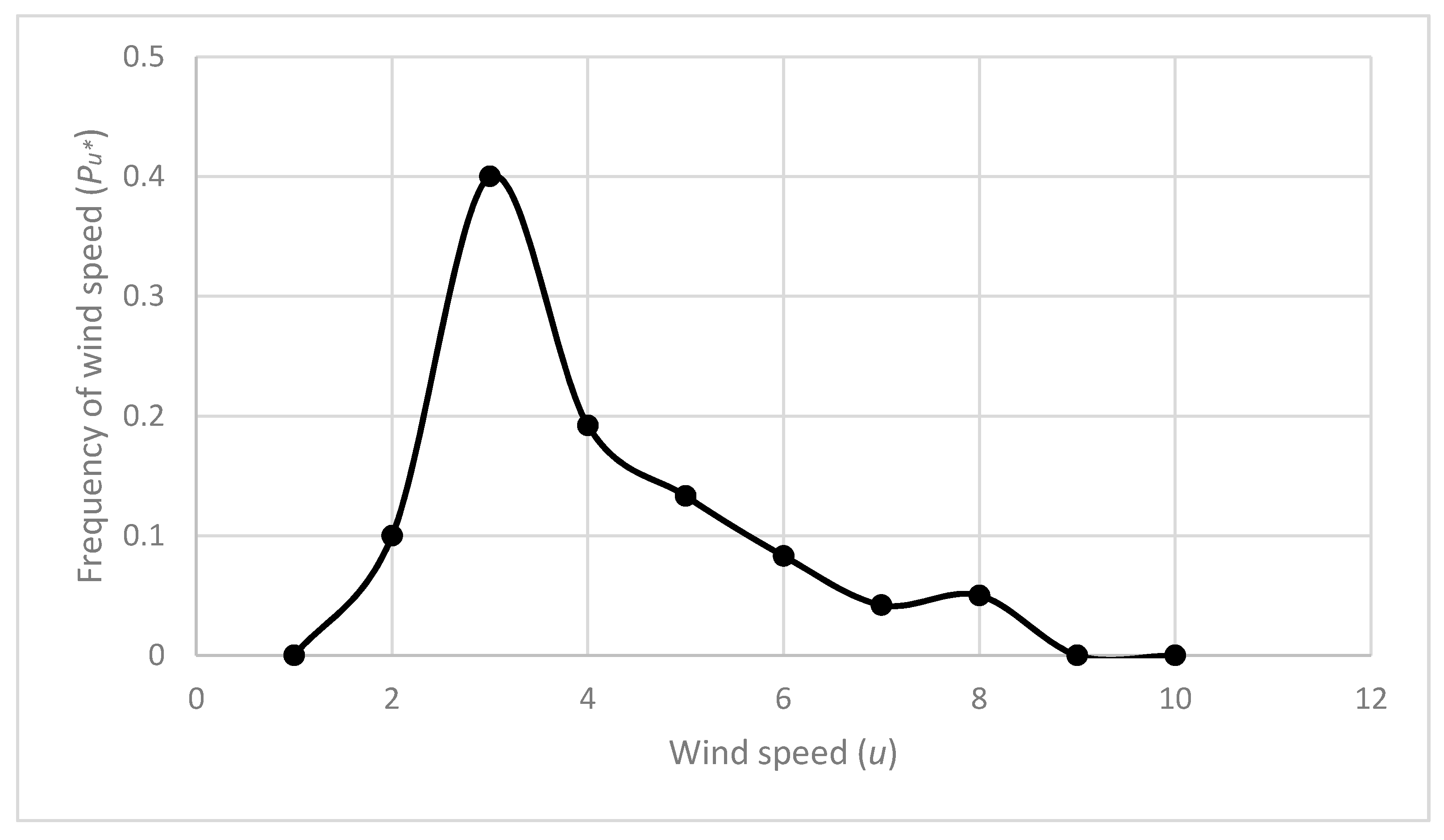
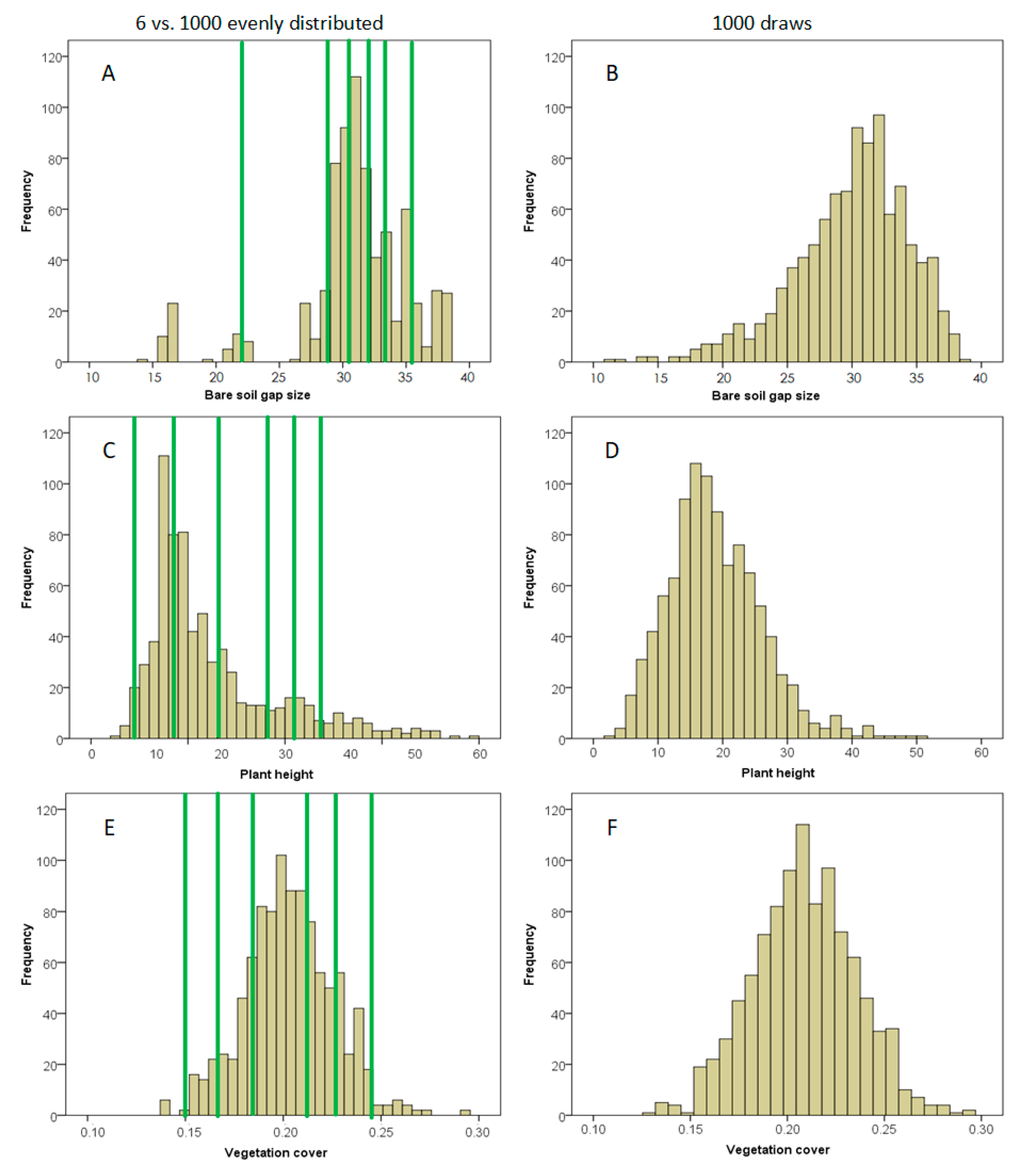
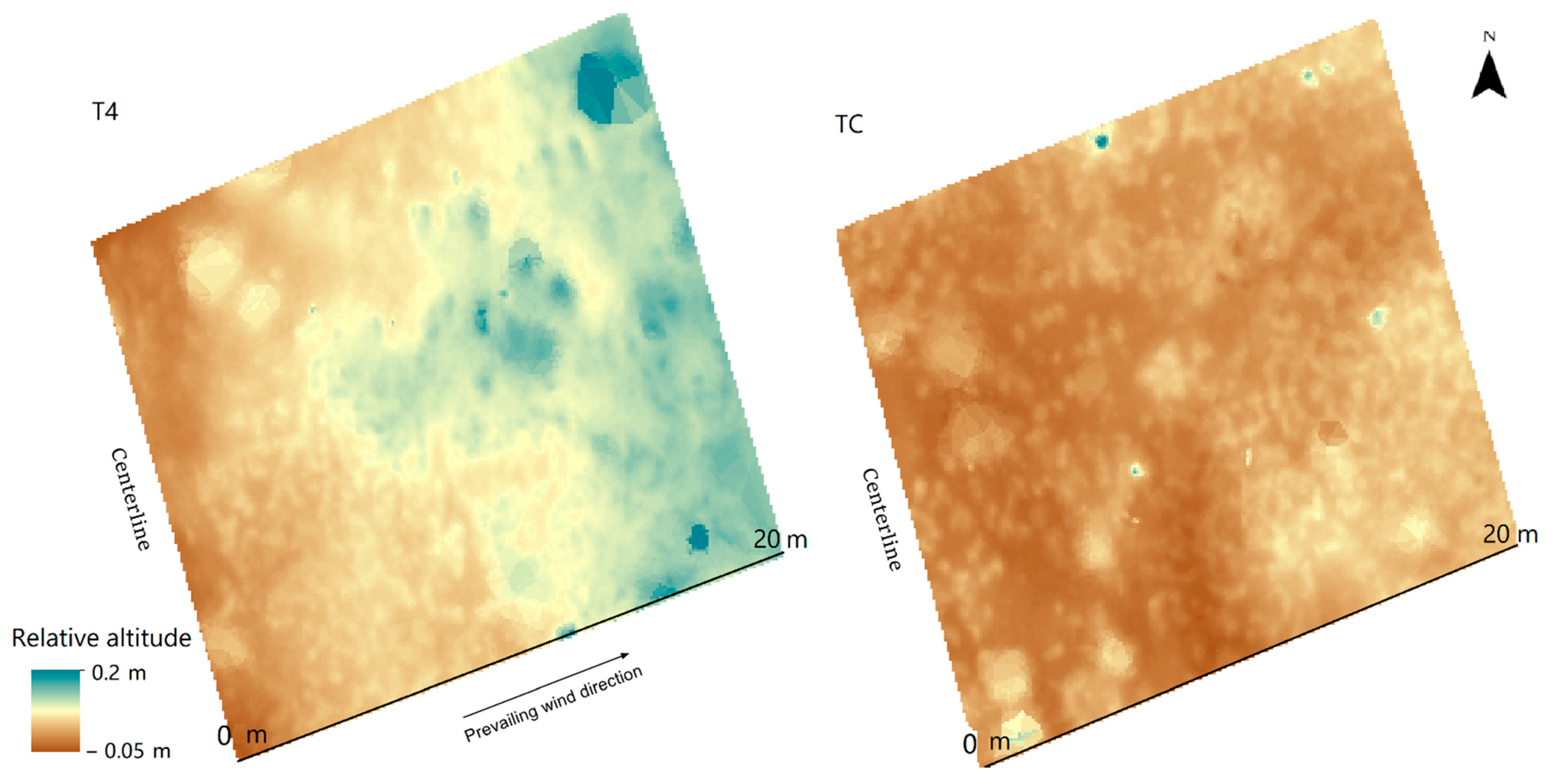
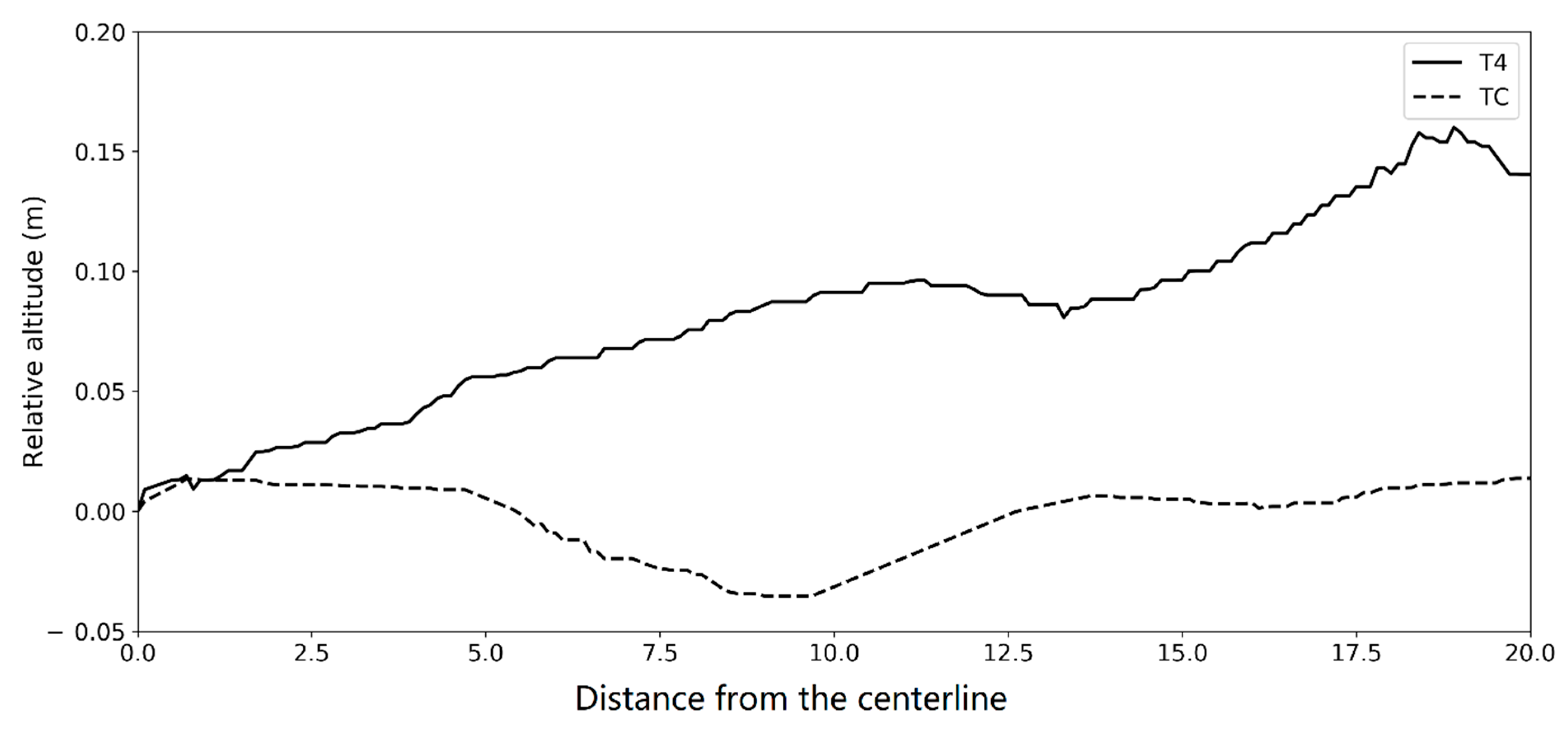
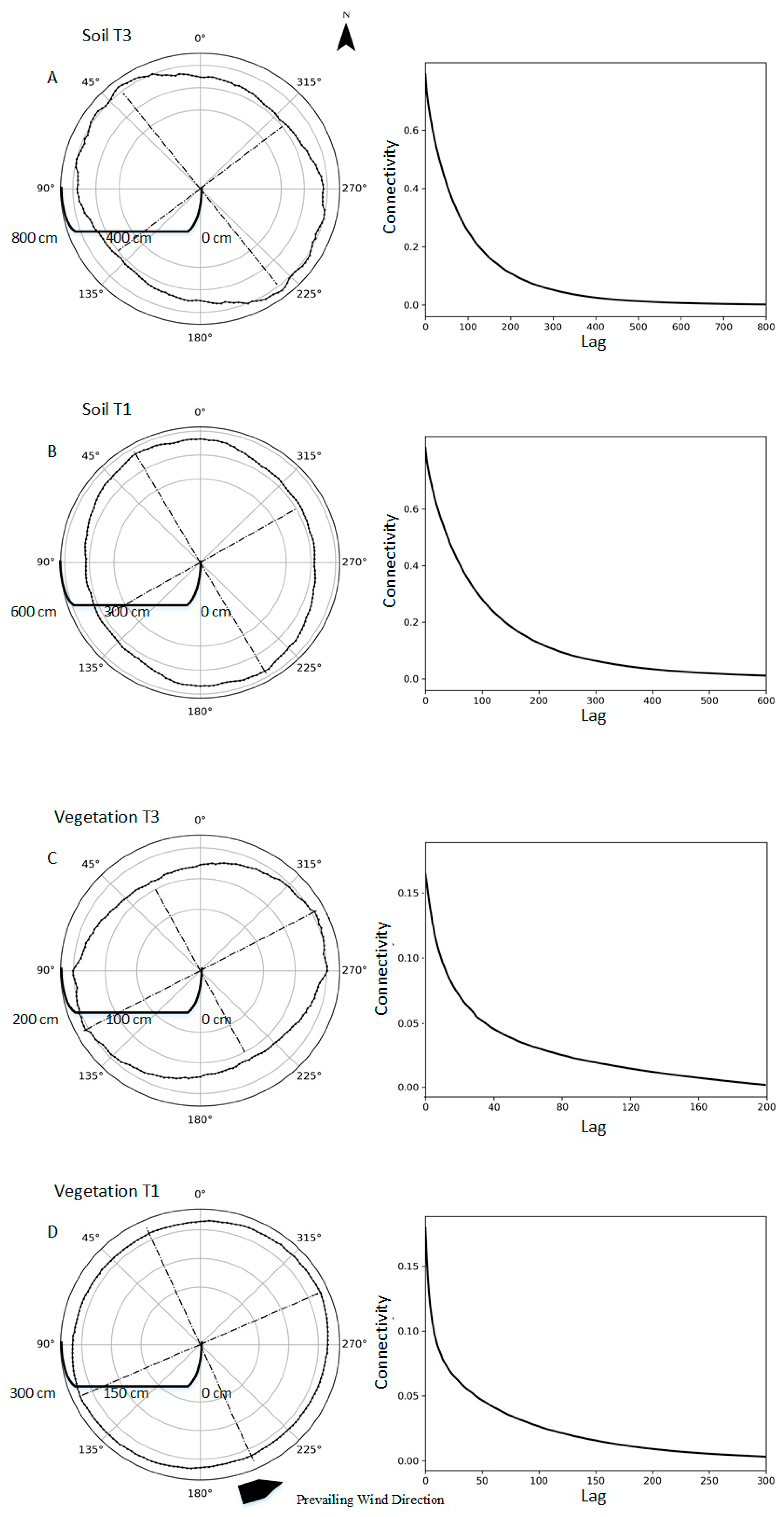
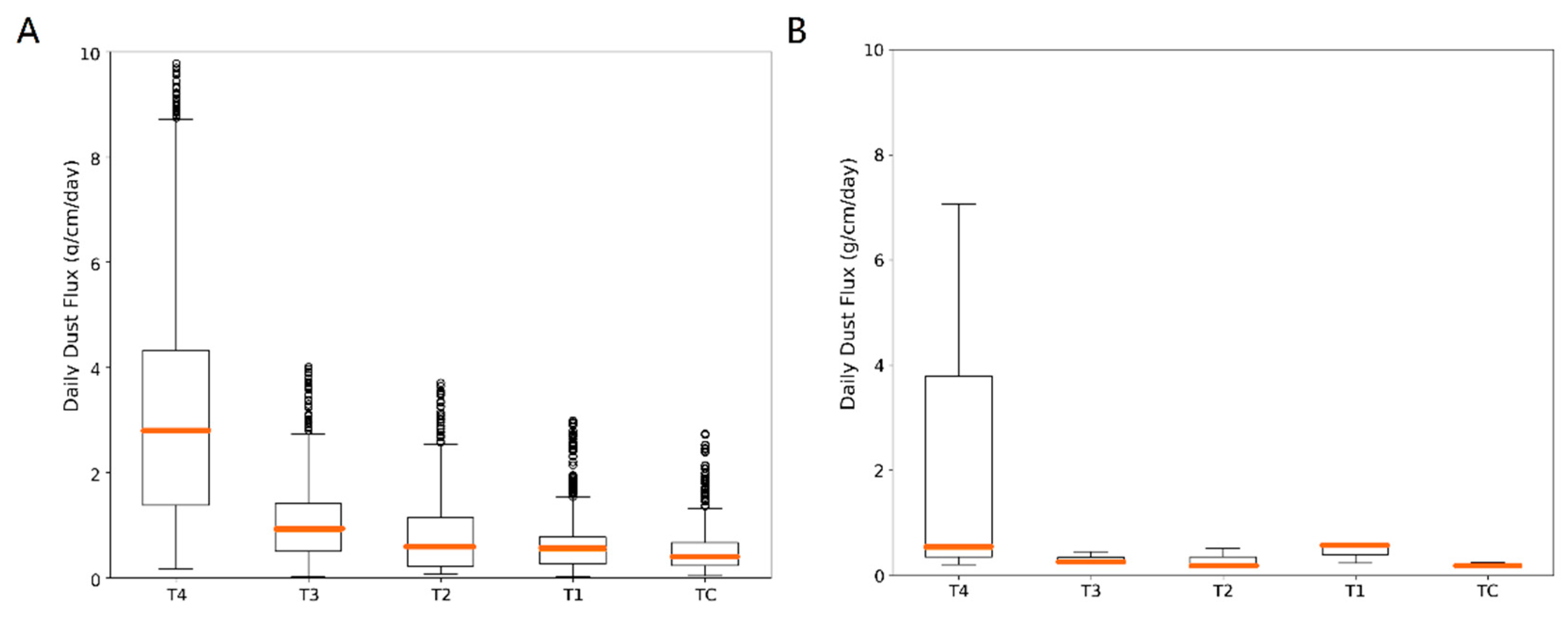
| List | Specification |
|---|---|
| Aircraft | DJI Phantom 4 |
| Sensor | DJI 4K camera |
| Image size | 4000 × 3000 |
| Camera type | Frame |
| Flying height (m) | 20 |
| Time of shot (s) | 1 |
| Image sidelap (%) | 70 |
| FOV (degree) | 94 |
| Image count | ~300 |
| Average point density (points/m2) | 1220 |
| Orthomosaic resolution (mm) | 7 |
| DSM cell size (cm) | 2.8 |
| GPS information | Yes |
| X | Y | Z | Total XY | |
|---|---|---|---|---|
| RMSE (cm) | 1.52 | 2.49 | 1.46 | 2.92 |
| ME (cm) | 3.71 | 2.82 | 4.03 | 3.45 |
| Mean | Standard Deviation | Confidence Interval of Mean | Confidence Interval of Standard Deviation | ||
|---|---|---|---|---|---|
| Vegetation cover (%) | 6 transect lines | 21.4 | 0.0733 | 0.0145 | 0.0923 |
| 1000 transect lines | 20.9 | 0.0320 | 0.0080 | 0.0400 | |
| 1000 draws | 20.7 | 0.0265 | 0.0016 | 0.0110 | |
| Bare soil gap size (cm) | 6 transect lines | 3023.98 | 920.576 | 34.67 | 89.76 |
| 1000 transect lines | 3343.39 | 887.472 | 28.93 | 62.20 | |
| 1000 draws | 3293.53 | 798.725 | 14.90 | 34.68 | |
| Plant height (cm) | 6 transect lines | 19.15 | 15.20 | 2.280 | 1.620 |
| 1000 transect lines | 14.23 | 10.80 | 1.920 | 1.410 | |
| 1000 draws | 18.90 | 7.19 | 0.440 | 0.616 | |
| Bare Soil Cover | Vegetation Cover | |
|---|---|---|
| Field measurement | 71.7% | 28.3% |
| Drone-based estimate | 79.5% | 20.5% |
| MODIS pixel | 82.3% | 17.7% |
Publisher’s Note: MDPI stays neutral with regard to jurisdictional claims in published maps and institutional affiliations. |
© 2021 by the authors. Licensee MDPI, Basel, Switzerland. This article is an open access article distributed under the terms and conditions of the Creative Commons Attribution (CC BY) license (http://creativecommons.org/licenses/by/4.0/).
Share and Cite
Zhang, J.; Guo, W.; Zhou, B.; Okin, G.S. Drone-Based Remote Sensing for Research on Wind Erosion in Drylands: Possible Applications. Remote Sens. 2021, 13, 283. https://doi.org/10.3390/rs13020283
Zhang J, Guo W, Zhou B, Okin GS. Drone-Based Remote Sensing for Research on Wind Erosion in Drylands: Possible Applications. Remote Sensing. 2021; 13(2):283. https://doi.org/10.3390/rs13020283
Chicago/Turabian StyleZhang, Junzhe, Wei Guo, Bo Zhou, and Gregory S. Okin. 2021. "Drone-Based Remote Sensing for Research on Wind Erosion in Drylands: Possible Applications" Remote Sensing 13, no. 2: 283. https://doi.org/10.3390/rs13020283
APA StyleZhang, J., Guo, W., Zhou, B., & Okin, G. S. (2021). Drone-Based Remote Sensing for Research on Wind Erosion in Drylands: Possible Applications. Remote Sensing, 13(2), 283. https://doi.org/10.3390/rs13020283




